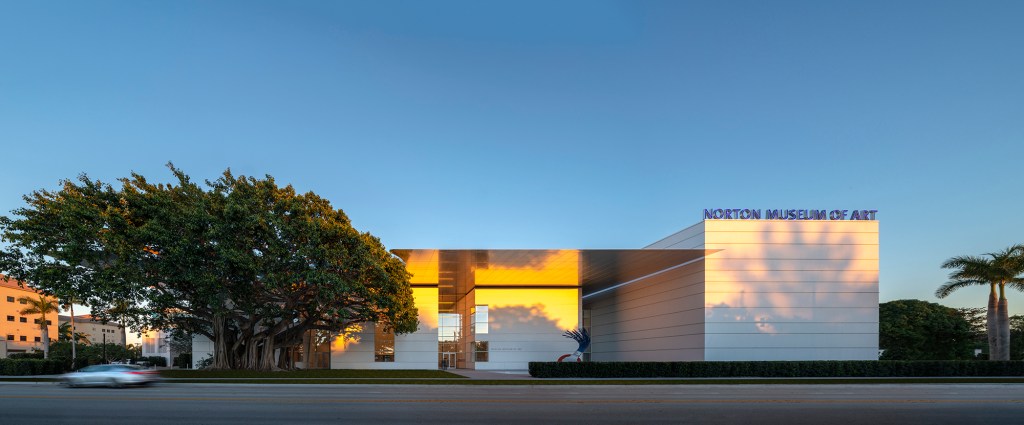How does a little museum in South Florida snag a high-profile international maven like Norman Foster, Hon. FAIA, whose client list includes the British Museum in London, the Smithsonian in Washington, D.C., and the Prado in Madrid? This is the question I put to Hope Alswang who, as executive director and CEO of the Norton Museum of Art in West Palm Beach, oversaw a major expansion and renovation of the museum by the celebrated British architect.
Alswang described a meeting nine years ago with Gilbert C. Maurer, the Norton Museum board member who had chaired the search committee that had just tapped her to be the new director. Maurer was COO of the Hearst Corp., and they met in his office on the 43rd floor of the Hearst Tower in New York. “We were discussing how the museum should move forward,” she recalled. “We agreed that what we needed was a master plan, and Gil asked me who I would like to do the job. Rather cheekily I answered, ‘What about Norman Foster?’ ”
Alswang knew that Foster was the architect of the Hearst Tower, completed four years earlier. What she didn’t know was that Maurer had worked closely with Foster on the project. “Gil picked up the phone and called the Foster + Partners New York office, which was in the same building. Michael Wurzel, a partner, immediately came up and we talked about what was involved in a master plan. That’s how it started.”
“When architects design new additions for older museum buildings, frequently the new outshines—or simply ignores—the old. … That is not the case here.”
Alswang didn’t exactly pull Foster’s name out of a hat. “I knew that my board would want a Pritzker Prize winner, and I wanted a rational modernist who would build a building that respected art. There have been a number of museum additions where that has been a problem.” Alswang was too diplomatic to name names; perhaps she was thinking of Daniel Libeskind, FAIA’s 2006 addition to the Denver Art Museum, which Christopher Hawthorne, in the Los Angeles Times, called “a pretty terrible place for showing and looking at art.”) Alswang had seen Foster’s work at the British Museum and the Imperial War Museum in London, as well as his first art gallery, the 1978 Sainsbury Centre for the Visual Arts at the University of East Anglia. She had also visited the Reichstag in Berlin, which the architect had renovated in the late 1990s. “I knew that Foster was interested in combining the new with the old, and that was one of our main issues.”
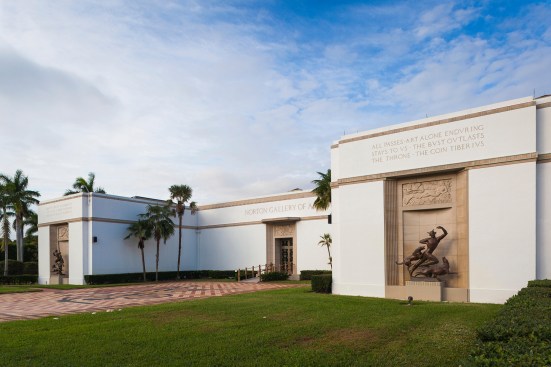
Danita Delimont/Alamy
Wyeth & King’s original Art Moderne entrance to the Norton Museum of Art
The Legacy of a Society Architect
The Norton Museum of Art was built in 1941, designed by the Palm Beach firm of Wyeth & King. Marion Sims Wyeth (1889–1982) was a prize-winning graduate of the École des Beaux-Arts who apprenticed with Bertram Goodhue and Carrère & Hastings. After serving in the Royal Flying Corps during the First World War, Wyeth established a practice in Palm Beach, becoming what was then called a society architect. He was an eclectic, often working in the Spanish Colonial Revival style pioneered by Goodhue and popularized locally by Addison Mizner. He designed a beautiful Moorish mansion in Honolulu for Doris Duke. Wyeth’s residential clients in Florida included Ralph and Elizabeth Norton, whose house he renovated in the then-popular Monterey Colonial style. When Norton, who belonged to a prominent Chicago family, retired as president of the Acme Steel Co., he and his wife settled in West Palm Beach, where they had been wintering for years. The pair were serious art collectors, and in 1940 they decided to found a museum and art school to house their sizable collection.
The Nortons turned to Wyeth. He designed a low, flat-roofed building with white stucco walls and limestone trim in a style that is often called Art Deco. Wyeth’s design has little to do with the frothy confections of South Beach, however, and is more in the vein of Holabird & Root’s Palmolive Building in Chicago (1929), Paul Cret’s Folger Shakespeare Library (1932), and Raymond Hood’s Rockefeller Center (1930-39). More accurately called Art Moderne, this American version of early Modernism is distinguished from the European International Style by its respect for the classical tradition, its discreet use of ornament, and its integration of artwork with architecture. The last is evident in the Norton Museum’s façade, which includes two sculptures and three bas-reliefs by Paul Manship, a leading sculptor at the time and the author of Rockefeller Center’s Prometheus. The façade also displays these lines from Théophile Gautier: “All passes. Art alone enduring stays to us; the Bust outlasts the throne, the Coin, Tiberius.”
Wyeth’s rigorous Beaux-Arts plan was a group of pavilions symmetrically organized around an outdoor court. The intimate galleries resembled the rooms of a large villa. By the time that Alswang commissioned Foster, however, two infelicitous additions in 1997 and 2003 had compromised Wyeth’s intentions by shifting the entrance to the side to facilitate car access and provide parking. The result recalled nothing so much as a suburban shopping center.
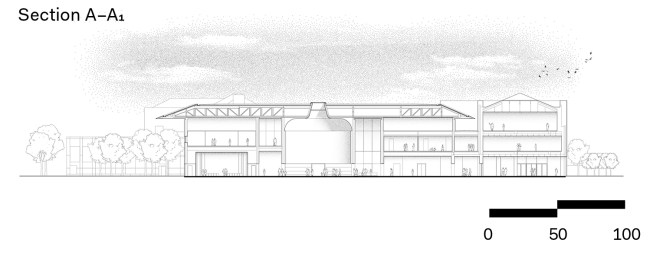
Museum section
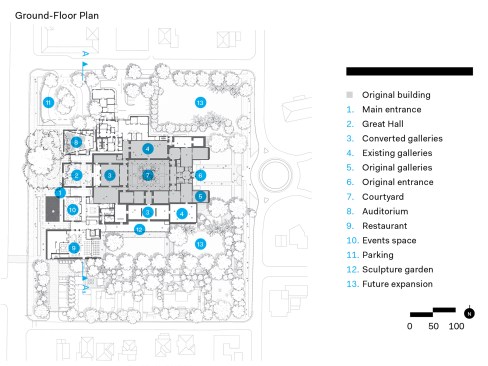
courtesy Foster + Partners
Ground floor plan
“We first looked at re-establishing the original front door,” Alswang told me. The problem was that the museum’s main parking lot, which was on the far side of South Dixie Highway, a broad avenue at the back of the building, was simply too far away. Foster’s solution was to move the main entrance to face the avenue, which not only solved the parking issue but also gave the museum a more visible public face. At the same time, he reinforced the prime axis of the original building, replaced the side entrance with a new gallery, and turned the adjacent parking area into a lush subtropical garden. The master plan also envisaged two pavilions flanking Wyeth’s original entrance to accommodate growth in the undetermined future.
“We were thinking maybe a $20 million thing,” Alswang told the Palm Beach Daily News. It turned into a $100 million thing instead.
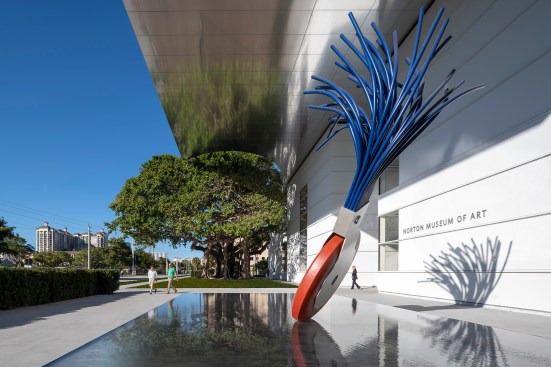
Nigel Young/Foster + Partners
Claes Oldenburg and Coosje van Bruggen’s Typewriter Eraser, Scale X, in front of the new entrance
Alswang was not without experience in museum building. Before joining the Norton Museum she had worked with Rafael Moneo, Hon. FAIA, on an addition to the Rhode Island School of Design Museum, of which she was director. “All top architects are expensive,” she told me. “It’s not so much the design cost as the cost of building well. For example, we built a full-size mock-up of a corner of the building to test different alternatives.”
All the Modern Amenities
The reconfigured and enlarged Norton Museum opened in February. Like Wyeth’s original entrance façade, the new “public face” features a work of art—Claes Oldenburg and Coosje van Bruggen’s Typewriter Eraser, Scale X. But the real attention grabber is a huge banyan-like Ficus altissima that had been planted when the original museum was built. The building appears to embrace the tree—the cantilevered aluminum roof canopy, that resembles an airplane wing, has a curved cutout to accommodate the 100-foot-wide arboreal giant.
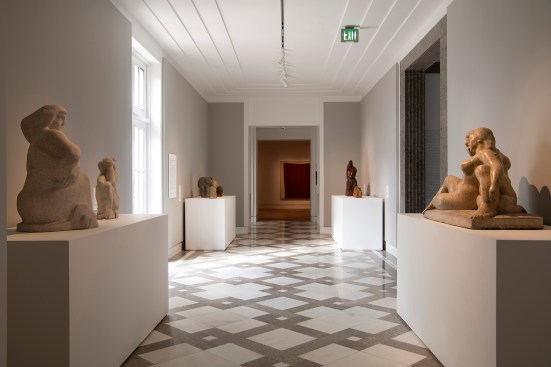
Nigel Young/Foster + Partners
A refreshed existing gallery
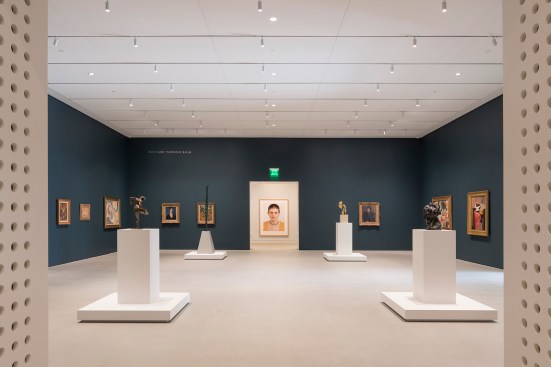
Nigel Young/Foster + Partners
A new gallery
The original Norton collection consisted chiefly of European and American art as well as Chinese pottery and paintings, later augmented by contemporary art and photography. Of the museum’s 130,000 square feet of gallery space, only about 10,000 square feet are new. The rest of the Foster addition includes additional classrooms, a 210-seat raked auditorium, and a room that the museum calls the Great Hall. In the past, a “great hall” in a museum was a monumental space, like the Pantheon-like rotundas of Karl Friedrich Schinkel’s Altes Museum in Berlin and John Russell Pope’s National Gallery of Art in Washington, D.C. Times have changed. Foster’s Great Hall is more like a large living room, furnished with groups of easy chairs and low tables, art books for browsing, and a convenient coffee bar. A lingering vestige of the neoclassical past is a rather mysterious oculus in the domed ceiling that recalls a James Turrell “skyspace.”
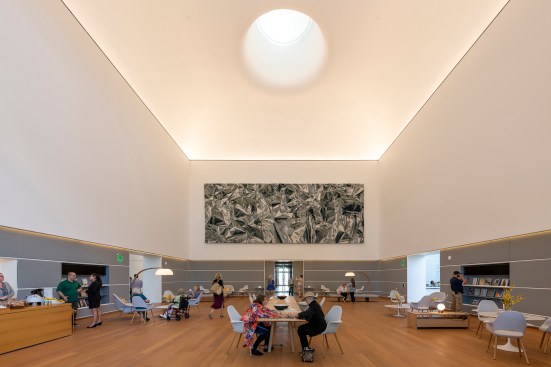
Nigel Young/Foster + Partners
The Great Hall, which is lit by an oculus in the ceiling
The Norton Museum addition also includes an amenity that’s become commonplace in museums: a restaurant. I’m not sure when museums first provided their visitors with a place to eat; the Museum of Modern Art in New York had a restaurant (with a garden terrace) as early as 1939. My vague memory of early museum restaurants is that they had Eames or Breuer chairs as well as a modern decor; in short, they were distinctly different from regular restaurants. Today, with so many commercial restaurants embracing modern design, how is a museum eatery to distinguish itself? Frank Gehry, FAIA’s new restaurant in the Philadelphia Museum of Art takes the minimalist road—and all that Douglas fir plywood creates the charmless atmosphere of a high-school cafeteria. Foster’s restaurant at the Norton has the advantage of an outdoor terrace and the surrounding garden, although its high-style chairs (a very comfortable design from the German company Walter Knoll) and somewhat austere decor reminded me of an upscale spa. Perhaps there should be some art on the smooth concrete walls?
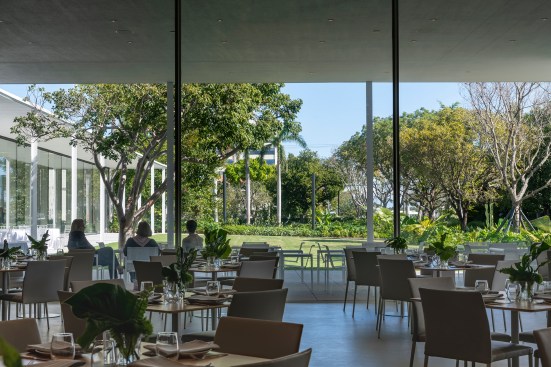
Nigel Young/Foster + Partners
The Norton Museum restaurant overlooks the new subtropical garden
Maintaining an Intimate Scale
When architects design new additions for older museum buildings, frequently the new outshines—or simply ignores—the old, a charge that has been leveled at Snøhetta’s recent addition to the San Francisco Museum of Modern Art. The usual rationalization is that hardy chestnut, “contrast.” That is not the case here. The new architecture does not overwhelm the intimate scale that is one of the charms of the Norton. Moreover, the new addition blends seamlessly with the old museum as the visitor moves effortlessly from the entrance area to the galleries. This is partly because the old galleries have been freshened up—repainted, new LED lighting installed, carpeting taken up to reveal the original oak floor—and partly because the new layout is informed by the axial Beaux-Arts plan.
Foster + Partners is too much of a modernist firm to attempt an updated version of Art Moderne, yet there are subtle stylistic touches. The horizontal stripes on the consistent stucco exterior and on the walls of the Great Hall are a low-key reminder that streamlining was often part of Art Moderne buildings. So are the polka dot patterns on the front doors that are echoed, on a smaller scale, in the auditorium. Neither reference is literal, yet they function as effective visual cues.
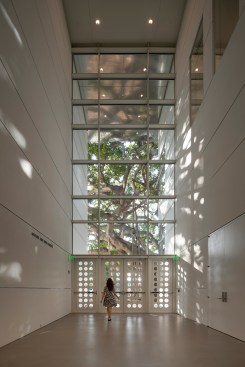
Nigel Young/Foster + Partners
The polka-dot pattern on the doors and the wall stripes are subtle Art Moderne touches
During a 2017 press briefing in New York to unveil the design of the addition, Alswang (who retired last March) said it would be a dramatic upgrade—like going from “driving a Subaru to driving a Maserati.” I’ve never driven a Maserati, but I have owned a Subaru and a Mercedes. They both had four wheels, four doors, and a steering wheel; the chief difference was in the details: the precision of the bodywork, the ergonomic controls, the solidity of the handling. I think that the renovated and enlarged Norton Museum can also be found in the details: Precise, carefully thought out, meticulously assembled, and solid—made to last. The doors close with a nice thunk, too.
